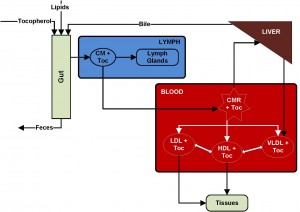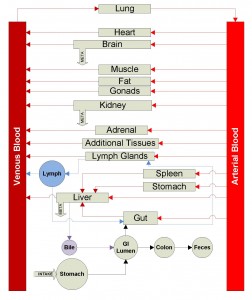
α-tocopherol is the primary component of vitamin E, and is responsible as an anti-oxidant in the human body and has been shown to alleviate cellular damage due to oxidative stress. There is currently no existing PBPK model for tocopherol. We developed a PBPK model for α-tocopherol considering known mechanisms of absorption and metabolism of tocopherol.

Tocopherol being a highly lipophilic compound is highly insoluble in the aqueous medium of the gut and hence is absorbed along with the fats present in the diet. The gastro-intestinal absorption of tocopherol follows the absorption of fat closely. The PBPK model includes flow of lymph and bile, in addition to arterial and venous blood and considers tocopherol binding to LDL (low density lipoproteins), HDL (high density lipoproteins), and VLDL (very low density lipoproteins).
 The PBPK model implemented in rats also considers tocopherol transport into brain explicitly using LDL and HDL receptor levels in the blood-brain barrier.
The PBPK model implemented in rats also considers tocopherol transport into brain explicitly using LDL and HDL receptor levels in the blood-brain barrier.
Read the full report for the PBPK modeling of tocopherol here: Report-Tocopherol-PBPK